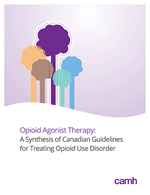Text adapted in 2023 from "Opioid Use and Opioid Use Disorders" in The Primary Care Addiction Toolkit. Available online only.
Opioid use and primary care
Opioid use occurs on a spectrum from low-risk to unhealthy use, which includes opioid use disorder. The number of people in treatment for opioid addiction has risen sharply in recent years. In Ontario, most family physicians have had concerns about opioid use in one or more of their patients. This toolkit describes what primary care providers need to know about unhealthy opioid use and opioid use disorders, including:
- how to identify patients at risk for unhealthy opioid use
- how to prescribe opioids for chronic non-cancer pain and monitor patients at risk for unhealthy opioid use
- how to treat chronic non-cancer pain in patients who have an opioid use disorder
- how to treat opioid use disorder.
Although opioids have the potential to become addictive, most people who are prescribed opioids to manage pain are not at risk for unhealthy use and do not develop an addiction. Prescribing practices that support safe opioid use are outlined in the 2017 Canadian Guideline for Opioids for Chronic Non-cancer Pain (Busse et al., 2017).


